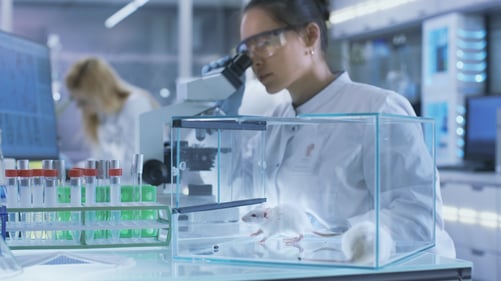In recent years, we have seen an explosion in the number of adeno-associated virus (AAV) vector-based gene therapies progressing to clinical trial stages, and subsequently an increasing number of regulatory successes. The reasons for this are clear. The versatility of AAV-based platforms makes them prime technology for targeting a range of tissues and pathologies, through their ability to silence, replace or modify genes.
However, this increased focus on AAV-based therapies is bringing attention to upstream issues in the development pipeline. Setbacks are becoming more frequent as animal models fail to deliver translational accuracy when it comes to key measures, such as biodistribution, transduction efficiency and toxicity. Even non-human primate (NHP) models are failing to fully predict AAV transduction in the human liver since it is impossible to target the human gene of interest.
The PXB-mouse® humanized liver model gets researchers closer to human outcomes
Pre-clinical animal models are critical to many therapy development pipelines, used with the hope of providing accurate efficacy and toxicity data so that therapies most likely to safely reach clinical endpoints are selected. These models must demonstrate reliable translation to the human environment while also being cost-effective and simple to use. However, discrepancies in AAV biodistribution and efficacy are often seen between pre-clinical animal models (particularly rodents) and clinical trial data. Most alarming are the incongruities between tissue transduction efficiency and hepatotoxicity.
The PXB-mouse® offers a novel alternative. This chimeric rodent model, with a humanized liver, offers up to 95% engraftment of human hepatocytes with a highly stable expression of human genes and proteins. What’s more, PXB-mouse livers secrete human albumin and possess functional human enzymes and transporters.
As AAV-based therapies reach later stages of development, the PXB-mouse® model can be used to accurately assess human hepatotoxicity, transduction and translational efficiency, which is critical when lead candidates are being assessed for clinical trial stages. As a results, researchers can elucidate the insights needed to ensure they select the therapeutics that have a greater chance of trial success.
PXB-mice accurately model human liver physiology in a preclinical platform
Following the success of its gene-therapy candidate (AAVRh. 10-CAG-A1AT) in treating autosomal co-dominant disease alpha-1 antitrypsin (A1AT) deficiency in preclinical C57BL/6J wild-type mouse model, Adverum Biotechnologies progressed the gene-based technology to clinical trial stages. However, disappointment followed when the candidate failed to reach its endpoint in Phase 1/2 trials. In humans, researchers observed a 20-50-fold decrease in transgene product when compared to the mouse model, indicating that the expected transduction efficiency wasn’t recreated in the human environment.
Adverum decided to trial the AAV-based therapy candidate in PXB-mice to see whether transduction in this model would be comparable to the human data, thus providing evidence of better human translation. The PXB-mouse® model produced similar levels of transgene product seen in clinical trials (Figure 1).
.png?width=413&height=427&name=adverum%20(1).png) Figure 1. Four different AAV cassettes were tested for transgene expression. Overall 20 – 50-fold lower secretion of transgene product was observed in the PXB-mouse compared to C57BL/6J mice, reminiscent of the low levels of A1AT transgene expression observed in human clinical trials.
Figure 1. Four different AAV cassettes were tested for transgene expression. Overall 20 – 50-fold lower secretion of transgene product was observed in the PXB-mouse compared to C57BL/6J mice, reminiscent of the low levels of A1AT transgene expression observed in human clinical trials.
These data provide strong evidence that the PXB-mouse® model can predict human outcomes better than the C57BL/6J wild-type mouse model. By using the PXB-mouse® model, scientists can identify the most promising candidates to take to clinical trials, thereby improving transduction and translation efficacy and decreasing the risk of late-stage clinical failures due to poor therapeutic transduction, expression, or efficacy.
For more educational content, and to read our other blogs, visit our website: https://www.phoenixbio.com/news/tag/blog

